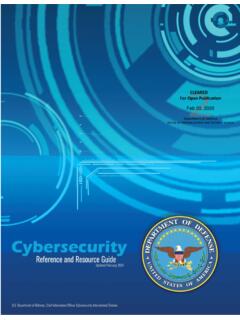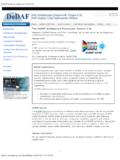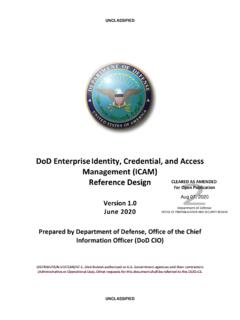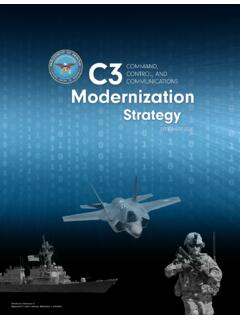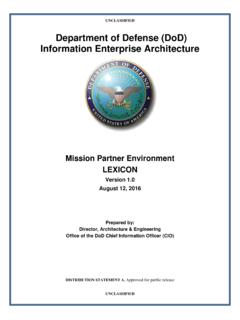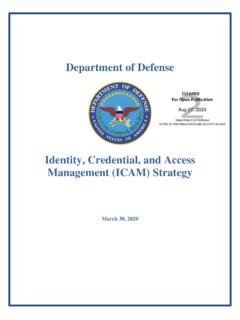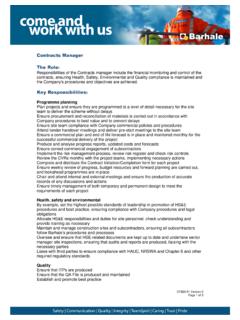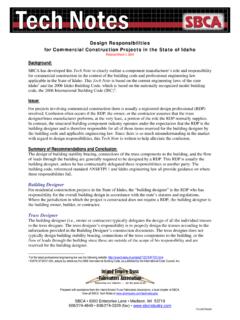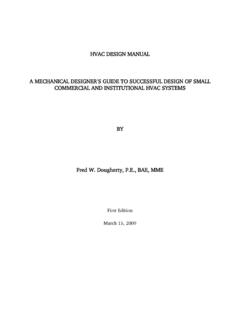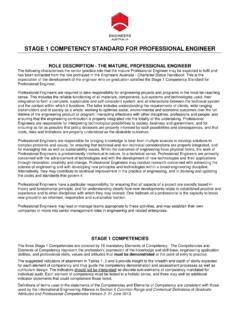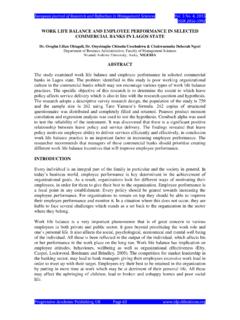Transcription of Unclassified
1 Unclassified Unclassified Department of Defense (DoD) Cloud Native Access Point ( CNAP) Reference design (RD) Version 29 July 2021 DISTRIBUTION STATEMENT A. Approved for public release: distribution unlimited. Refer to the Deputy Chief Information Officer for Information Enterprise (DCIO IE) for other requests that pertain to this document. Unclassified ii Unclassified Prepared By: Unclassified iii Unclassified Version History Version Date Approved By Summary of Changes 2021/07/29 DCIO-IE DMI EXCOM Approved Unclassified iv Unclassified Executive Summary The ability to deliver capability at the speed of relevance requires an innovative approach to providing secure access to cloud environments. As highlighted in a recent report by the Defense Innovation Board, ..the threats that the United States faces are changing at an ever-increasing pace, and the Department of Defense s (DoD s) ability to adapt and respond is now determined by its ability to develop and deploy software to the field rapidly.
2 To effectively and efficiently achieve the objective, access to cloud environments must be flexible, ubiquitous, and at the same time, provide the requisite level of security and monitoring to protect from, detect, respond to, and recover from cyber-attacks. The purpose of a Cloud Native Access Point (CNAP) is to provide secure authorized access to DoD resources in a commercial cloud environment, leveraging zero trust architecture (ZTA), by authorized DoD users and endpoints from anywhere, at any time, from any device. The purpose of this CNAP Reference design (RD) is to describe and define the set of capabilities, fundamental components, and data flows within a CNAP. It presents logical design patterns and derived reference implementations for deploying, connecting to, and operating a CNAP. It is a future state design to guide the development of next generation connectivity and cybersecurity capabilities to improve internet-based machine and user access into DoD cloud (in particular, commercial cloud-hosted) resources and services.
3 A CNAP provides person entities (PE) ( , end users and privileged users) and non-person entities (NPE) access to cloud enclaves using a combination of cloud native and cloud ready security mechanisms. Further, a CNAP allows authorized outbound access to the internet, for example, to enable software repository synchronization of COTS patches or new versions of Free and Open-Source Software (FOSS) projects and system-to-system interfaces with mission partners such as other Federal Departments. The CNAP RD is intended for the Combatant Commanders, Military Departments, Defense Information Systems Agency ( DISA), other Defense Agencies, and mission partners who require access to DoD resources in the commercial cloud and government cloud. It serves as DoD enterprise-level guidance for establishing secure internet ingress and egress to cloud-hosted development, test, and production environments.
4 Unclassified v Unclassified Contents Purpose .. 3 Scope .. 3 Intended 4 High Level User Stories .. 4 2. Assumptions and Principles ..7 Assumptions .. 7 Principles .. 7 3. Capability Overview ..9 CNAP Capability Taxonomy Overview (DoDAF CV-2) .. 10 Core CNAP Capabilities .. 11 - Authenticated and Authorized Entities .. 11 - Authorized Ingress .. 12 - Authorized Egress .. 14 - Security Monitoring and Compliance 15 Monitoring and Remediation .. 15 Compliance Auditing and Enforcement .. 15 Integrated Visibility with CSSP/DCO .. 15 Continuous Authorization to Operate (cATO) .. 16 4. Data Flows .. 17 CSP Portal Access .. 17 SaaS Access .. 17 Authorized Ingress .. 18 Authorized Egress .. 19 Security Monitoring and Compliance Enforcement .. 19 5. Logical design Patterns .. 21 Access to MO Cloud Enclave .. 21 Access to SaaS Services.
5 23 6. Implementation Responsibilities .. 26 DoD Enterprise Responsibilities .. 26 MO Responsibilities .. 26 Mission Partners .. 27 CSP Responsibilities .. 28 7. References .. 29 Appendix A Acronyms .. 30 Appendix B Glossary .. 33 Unclassified vi Unclassified Appendix C Recommended Policy 34 Figures Figure 1 Cloud Native Access Point Vision: Capability Viewpoint (CV-1) .. 9 Figure 2 Cloud Native Access Point Vision: Operational Viewpoint (OV-1) .. 10 Figure 3 CNAP Capability Taxonomy (CV-2) .. 11 Figure 4 CNAP Data Flow .. 17 Figure 5 High Level Monitoring and Compliance Data Flow .. 20 Figure 6 CNAP Access to MO Enclave .. 23 Figure 7 Access to SaaS Services .. 25 Figure 8 MO Roles and Responsibilities .. 27 Unclassified 2 Unclassified Introduction The pace of software development, testing, and delivery has increased significantly over the last 10 years.
6 This increase in speed is due largely to the use of cloud computing and adoption of Development, Security and Operations (DevSecOps1) practices as part of the software lifecycle. For DoD, creating a technical and tactical advantage in the battlespace relies on software modernization, based on a foundation of cloud computing and DevSecOps, for rapid delivery of capability to the warfighter. The ability to deliver capability requires an innovative approach to providing secure access to cloud environments for the continuous integration and continuous delivery (CI/CD) of software. Of equal importance is the ability for authenticated and authorized users to securely access cloud resources from any device, at any time, from anywhere. national security increasingly relies on software to execute missions, integrate and collaborate with allies, and manage the defense enterprise.
7 The ability to develop, procure, assure, deploy, and continuously improve software is thus central to national defense. At the same time, the threats that the United States faces are changing at an ever-increasing pace, and the Department of Defense s (DoD s) ability to adapt and respond is now determined by its ability to develop and deploy software to the field rapidly. Defense Innovation Board Currently, software development in the DoD is not optimized to rapidly procure, assure, deploy, and continuously improve. To optimize software development and increase the ability to adapt and respond to changing threats, a new cloud access capability is needed. With exception to environments like the Mission Partner Environment (MPE) or the Medical Community of Interest, the current implementation for accessing DoD Mission Owner (MO) commercial cloud enclaves from the internet is through DoD Internet Access Points (IAP), across the Defense Information Systems Network (DISN), and through boundary cloud access points (BCAP).
8 Therefore, access to DoD commercial cloud environments must traverse multiple, independently managed security stacks. While secure, this legacy design increases latency and can lead to network performance and quality of service problems, and it does not provide the flexibility, elasticity, timeliness, or efficiency needed. Rather, access to MO cloud enclaves must be flexible and ubiquitous, while providing the requisite level of security to defend DoD data and resources within commercial cloud-hosted environments. A CNAP creates an agile, highly scalable, and available security capability for access into MO cloud enclaves without going through a cloud access point that is hosted on the DoD Information Network (DoDIN). By leveraging cloud native security services and tools2, a CNAP is very efficient in terms of maintenance, management, monitoring, and compliance. It is also very effective in facilitating a Zero Trust Architecture by utilizing conditional access policies, micro-segmentation3, and continuous monitoring.
9 A CNAP is a virtual Internet Access Point (vIAP) that provides modernized cybersecurity capabilities based on the DoD Zero Trust Reference Architecture (ZTRA). It is an access point for person entities (PE) and non-person entities (NPE) to DoD resources in a commercial cloud environment from the internet ( , non-DODIN). This document establishes a vendor/solution agnostic RD, which is aligned with the DoD Digital Modernization Strategy and the DoD Cloud Computing Strategy, for implementing a CNAP that relies on 1 DevSecOps is a set of software development practices that combines software development (Dev), security (Sec), and information technology operations (Ops) to secure the outcome and shorten the development lifecycle ( ). 2 Cloud native services and tools are designed to leverage cloud capabilities and are optimized to run in cloud environments. These can be provided by the cloud service provider or by third party vendors.
10 3 Micro-segmentation is a logical division of the internal network into distinct security segments at the service/API level. Unclassified 3 Unclassified cloud hosted gateways and security services to support secure access from the internet for all types of DoD authenticated and authorized entities. While the RD is agnostic, examples of specific solutions are given to provide reference to available options. DoD does not endorse any specific vendor or solution for the CNAP RD. The CNAP design may be implemented at the DoD enterprise level to secure access to a software as a service capability ( , DoD365); as part of a platform to provide CNAP as a service for mission application owners ( , CNAP for USAF Platform One); or by mission application owners for secure access to their own virtual cloud environment from the internet. Determining implementation type is a MO decision.

